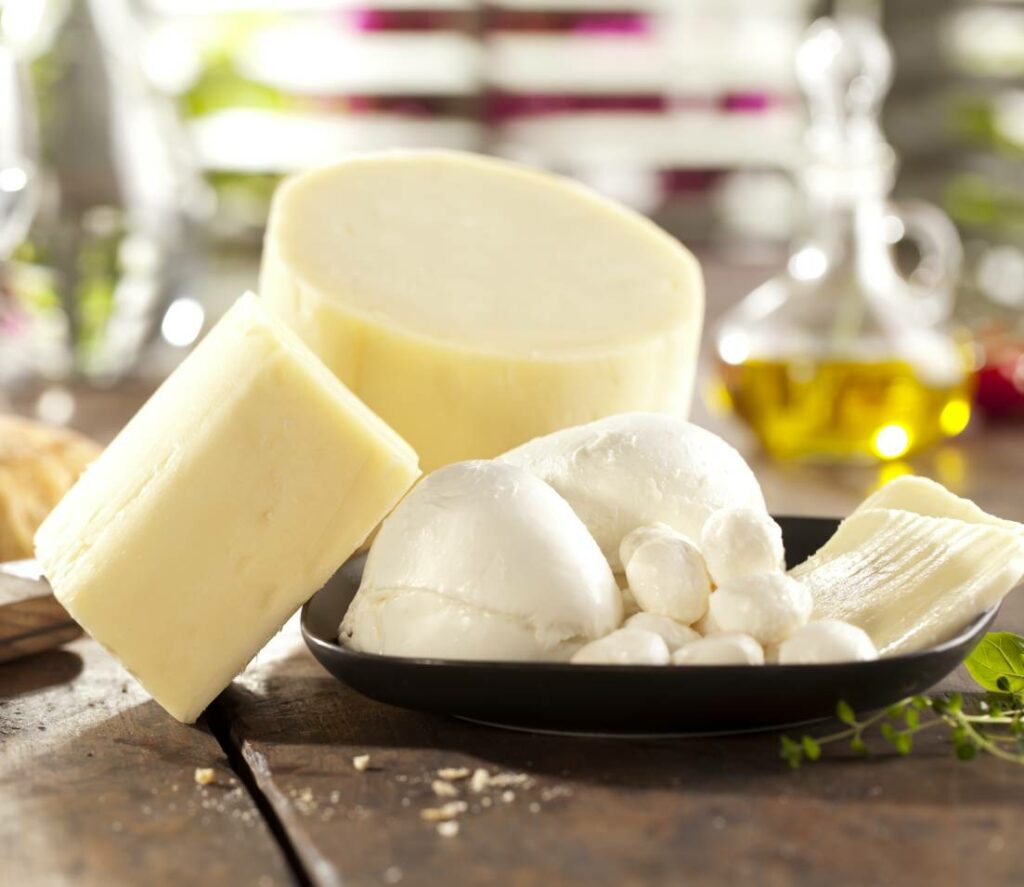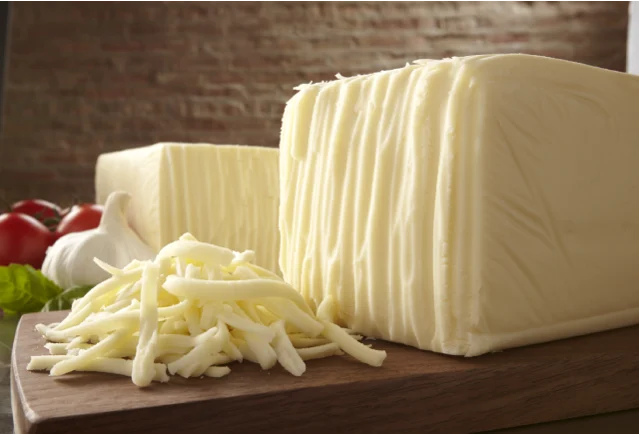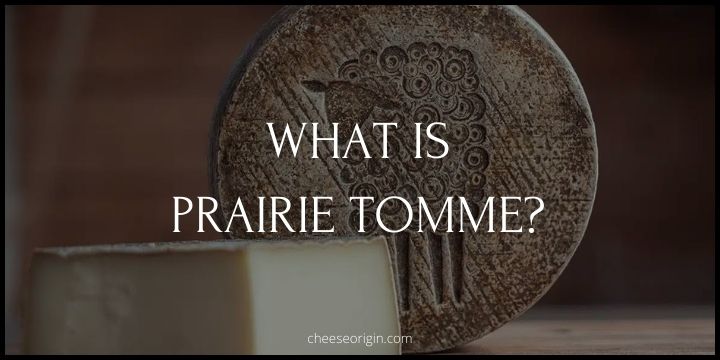What is Pasta Filata? Italy’s Stretched-Curd Cheese

Pasta Filata, which translates to “spun paste” in Italian, is a unique family of Italian cheeses known for their distinct stretched-curd technique. The term ‘stretched curd’ points to the method involved in its production where the curd mass is dipped into hot water until it softens, and then stretched and pulled, giving the cheese an elastic quality.
This process contributes to the cheese’s signature melting and stretching properties. Notable members of this cheese family include Mozzarella, Provola, Provolone, and Scamorza. These cheeses are celebrated for their versatility in culinary applications, from being a key ingredient in pizzas to starring in appetizers and main dishes.
Quick Facts About Pasta Filata
| Fact | Details |
|---|---|
| Origin | Italy |
| Meaning | ‘Spun paste’ or ‘stretched curd’ |
| Process | Involves heating the curds and stretching them. |
| Texture | Smooth, elastic, and stringy |
| Flavor | Mild to sharp, depending on aging |
| Types | Mozzarella, Provolone, Burrata, etc. |
| Melting Ability | Excellent, making it perfect for pizzas and casseroles |
| Color | Usually white, but can vary |
| Storage | Best when eaten fresh, but can be refrigerated |
| Nutrition | High in protein and calcium, but also high in fat |
| Pairings | Pairs well with tomatoes, basil, olive oil, and crusty bread |
| Famous Dishes | Pizza Margherita, Caprese salad, Lasagna |
| Aging Time | Can be eaten fresh or aged for several months |
| Milk Source | Traditionally made from buffalo’s milk, but cow’s milk is now commonly used too |
What is Pasta Filata?

Dive into the world of Italian cheesemaking, and you’ll soon encounter the artistry of Pasta Filata. This isn’t just a type of cheese; it’s an age-old technique that transforms simple curds into culinary masterpieces. The term “Pasta Filata” translates to “spun paste” or “stretched curd,” hinting at the unique process that gives these cheeses their characteristic texture and elasticity.
Pasta Filata cheeses begin their journey much like any other cheese, with milk being curdled to create curds and whey. But here’s where the magic happens: the curds are heated in warm water until they become stretchy and pliable. Then, cheesemakers skillfully knead and pull the curds, much like dough, until they achieve a smooth, shiny consistency. This stretching and folding process aligns the proteins in the cheese, resulting in its signature stringiness.
Among the family of Pasta Filata cheeses, you’ll find household names like Mozzarella, Provolone, and Burrata. Each boasts its unique spin on the Pasta Filata method, varying in aspects like aging time, shape, and flavor profile. Some Pasta Filata cheeses, like fresh Mozzarella, are enjoyed immediately after production, offering a milky, delicate flavor. Others, like Provolone, are aged to develop a sharper, more robust taste.
But perhaps the most loved feature of Pasta Filata cheeses is their incredible meltability. When heated, they become beautifully gooey without losing their shape, making them the star ingredient in beloved dishes like pizza, lasagna, and baked ziti.
Pasta Filata – it’s more than a cheese; it’s a testament to the craftsmanship and tradition rooted deep in Italy’s food culture. Whether enjoyed fresh in a Caprese salad or melted atop a Neapolitan pizza, Pasta Filata cheeses offer a taste of Italian heritage that’s as rich and layered as the process of their creation.
What Does Pasta Filata Taste Like?
Pasta Filata offers a delightful range of flavors that can satisfy any cheese lover’s palate. At its freshest, Pasta Filata cheese such as Mozzarella, Bocconcini, or Mozzarella di Bufala, presents a soft yet resilient texture that holds a creamy, mild flavor. The milk’s taste can still be clearly detected on the tongue, offering a delightful gastronomic experience as you savor each bite.
As these cheeses ferment further, they develop a tangier, richer taste that adds depth to their initial mildness. This complexity of flavor is part of what makes Pasta Filata so versatile and loved.
But the flavor journey doesn’t stop there. Some Pasta Filata cheeses undergo additional processes like aging or smoking to add more character to their profiles. Provolone, for example, can be aged to attain a stronger, more assertive flavor.
In essence, Pasta Filata cheeses can range from sweet and mild to tangy and rich. Whether enjoyed fresh in a salad, melted on a pizza, or savored on its own, Pasta Filata offers a unique taste that is both comforting and satisfying.
Pasta Filata Family
| Cheese Type | Texture | Flavor | Best Paired With |
|---|---|---|---|
| Mozzarella | Soft, creamy, and elastic | Mild, milky, slightly tangy | Tomatoes, basil, olive oil, pizza |
| Provolone | Semi-hard to hard, depending on aging | Sweet to sharp, smoky if smoked | Salami, crusty bread, red wine |
| Burrata | Soft, creamy interior with a mozzarella shell | Rich, buttery, milky | Fresh tomatoes, prosciutto, crusty bread |
| Caciocavallo | Semi-hard to hard, depending on aging | Mild to sharp, slightly salty | Grilled vegetables, cured meats, full-bodied wines |
| Scamorza | Semi-soft, dense | Mild, creamy, slightly salty | Grilled dishes, antipasti, white wine |
| Stracciatella | Soft, creamy, stringy | Fresh, milky, creamy | Bread, salads, pasta dishes |
| Oaxaca | Soft, stringy | Mild, slightly salty, buttery | Quesadillas, enchiladas, chili |
What is the Pasta Filata Method?
Creating Pasta Filata cheese involves a meticulous process that requires skill, patience, and attention to detail. Here’s a step-by-step breakdown of how this unique cheese is made:
- Milk Selection and Preparation: The process starts with the selection of high-quality milk. Depending on the specific type of Pasta Filata cheese being made, this could be cow’s, sheep’s, or buffalo’s milk. This milk is then pasteurized to kill any harmful bacteria.
- Curdling: Starter cultures and rennet are added to the milk to kickstart the curdling process. The milk is left to rest until it forms into a solid mass or curd.
- Cutting the Curd: The curd is then cut into smaller pieces to help separate the solid curds from the liquid whey. The size of the curd pieces can affect the final texture of the cheese.
- Heating and Stirring: The curd is gently heated and stirred. This further helps in expelling the whey and firming up the curd.
- Molding and Pressing: The curd is placed into molds and pressed to remove any remaining whey, forming the basic shape of the cheese.
- Heating the Cheese: The cheese is then removed from the mold and placed in hot water or whey. The heat makes the cheese pliable and ready for stretching.
- Stretching and Kneading: The warm cheese is stretched and kneaded, aligning the proteins and giving the cheese its characteristic stringy texture. This step is crucial for Pasta Filata cheeses and is where the name (which means “spun paste”) comes from.
- Shaping: The stretchy cheese is then shaped into the desired form. This could be anything from a small ball for mozzarella to a large wheel for provolone.
- Cooling and Brining: The shaped cheese is then cooled in cold water to retain its shape, and often brined for flavor and to help preserve the cheese.
- Aging: Depending on the type of cheese, it may be aged for several weeks to months to develop its flavor. Some Pasta Filata cheeses like fresh mozzarella are consumed immediately, while others like provolone are aged.
- Packaging and Distribution: Finally, the cheese is packaged and distributed to stores or directly to consumers.
Each step in this process plays a crucial role in creating the unique texture and flavor profile of Pasta Filata cheeses.
How to Eat Pasta Filata?
- Fresh and Simple: One of the best ways to enjoy fresh Pasta Filata cheeses like mozzarella or burrata is in their raw form, paired with ripe tomatoes, fresh basil, a drizzle of high-quality olive oil, and a pinch of salt. This combination, known as a Caprese salad, showcases the creamy, milky flavor of the cheese.
- Melting on Pizza: Pasta Filata cheeses are renowned for their excellent melting qualities. Scatter chunks of mozzarella over your favorite pizza before baking for a stretchy, gooey delight.
- In Pasta Dishes: Incorporate pieces of Pasta Filata into your pasta dishes. Burrata, for example, can be served atop spaghetti aglio e olio (garlic and oil) for a creamy twist.
- Grilled or Baked: Some Pasta Filata cheeses, like provolone and scamorza, can be grilled or baked. They hold their shape well when heated, developing a deliciously golden crust while remaining soft and gooey inside.
- In Sandwiches: Slices of Pasta Filata cheeses can elevate any sandwich. Try adding provolone to a classic Italian sub, or use mozzarella in a panini for a melty treat.
- Stuffed: Smaller Pasta Filata cheeses like bocconcini can be stuffed with ingredients like olives or sundried tomatoes for a flavorful bite-sized appetizer.
- In Soups: Melt pieces of mozzarella or provolone into tomato or minestrone soup for an added layer of richness and flavor.
- With Wine: Pair your Pasta Filata cheese with wine. Lighter, fresher cheeses like mozzarella pair well with crisp white wines, while aged cheeses like provolone complement full-bodied reds.
- In Salads: Toss cubes or balls of Pasta Filata cheese into salads. The creaminess of the cheese contrasts beautifully with the crunch of fresh vegetables.
- With Fruit: Fresh Pasta Filata cheeses pair exceptionally well with fruit. Try serving mozzarella with slices of peach or melon for a refreshing and balanced treat.
Remember, the key to enjoying Pasta Filata is to experiment and find your personal preference. Whether you enjoy it fresh, melted, baked, or grilled, this versatile cheese offers endless possibilities.
10 Best Pasta Filata Substitutes
| Substitute | Description | Best Used In |
|---|---|---|
| Monterey Jack | A semi-hard cheese with a mild, buttery flavor. It melts well, making it a good substitute for Pasta Filata cheeses. | Pizza, pasta, sandwiches |
| Gouda | A Dutch cheese that’s creamy with a slightly sweet flavor. It’s also an excellent melter. | Grilled cheese, casseroles, quiche |
| Havarti | A Danish cheese with a buttery, slightly tangy taste. Its smooth texture when melted makes it a good stand-in for Pasta Filata. | Sandwiches, pizza, pasta |
| Muenster | An American cheese known for its smooth texture and mild flavor. It melts beautifully. | Grilled cheese, quesadillas, pizza |
| Fontina | An Italian cheese with a nutty, slightly sweet taste. It melts well, making it a good alternative to Pasta Filata cheeses. | Fondue, pizza, pasta |
| Colby | An American cheese similar to cheddar but milder and softer. It’s a decent melter. | Sandwiches, burgers, mac and cheese |
| Cheddar | A widely available cheese with a strong, tangy flavor. Choose a mild cheddar for a closer match to Pasta Filata cheeses. | Sandwiches, soups, casseroles |
| Swiss Cheese | Known for its distinct holes and mild, nutty flavor. It melts well. | Fondue, sandwiches, quiches |
| Taleggio | An Italian cheese with a strong aroma but mild flavor. It’s creamy when melted. | Risotto, polenta, pasta |
| American Cheese | A processed cheese product that’s incredibly smooth and creamy when melted. While not as flavorful, it can mimic the texture of melted Pasta Filata cheeses. | Burgers, grilled cheese, mac and cheese |
What Pairs Well With Pasta Filata?

Food that goes well with Pasta Filata:
| Category | Food |
|---|---|
| Fruits | Strawberries, Pears, Grapes, Figs |
| Vegetables | Tomatoes, Roasted Bell Peppers, Grilled Zucchini, Artichokes |
| Breads | Baguette, Ciabatta, Crackers, Focaccia |
| Meats | Prosciutto, Salami, Mortadella, Bresaola |
| Seafood | Smoked Salmon, Grilled Shrimp, Marinated Anchovies, Seared Scallops |
| Grains | Ravioli, Gnocchi, Risotto, Farro Salad |
| Nuts & Seeds | Walnuts, Almonds, Pine Nuts, Sunflower Seeds |
| Herbs & Spices | Basil, Oregano, Rosemary, Black Pepper |
| Desserts | Dark Chocolate, Fruit Tarts, Panna Cotta, Cannoli |
| Condiments & Spreads | Honey, Fig Jam, Quince Paste, Olive Tapenade |
Also read: What Fruit Goes on a Charcuterie Board?
Beverage that goes well with Pasta Filata:
| Category | Beverage |
|---|---|
| Wine | Chardonnay, Pinot Grigio, Merlot, Cabernet Sauvignon |
| Beer | Pilsners, Lagers, Wheat Beers, Amber Ales |
| Non-Alcoholic | Sparkling Water, Lemonade, Iced Tea, Apple Juice |
Also read: Best Wine and Cheese Pairings: The Ultimate Guide
Also read:
- What is Mastelo Cheese? Greece’s Hidden Delicacy
- Top 11 Most Popular Semi-soft Cheeses in the World
- Top 10 Most Popular Cheeses in Ireland
- What is Lanark Blue? Scotland’s Roquefort Revolution
- What is Gorgonzola Piccante? Italy’s Sharp Blue Cheese Wonder
- What is Gorgonzola Dolce? Italy’s Creamy Blue Treasure
- What is Maytag Blue? America’s Signature Blue Cheese





